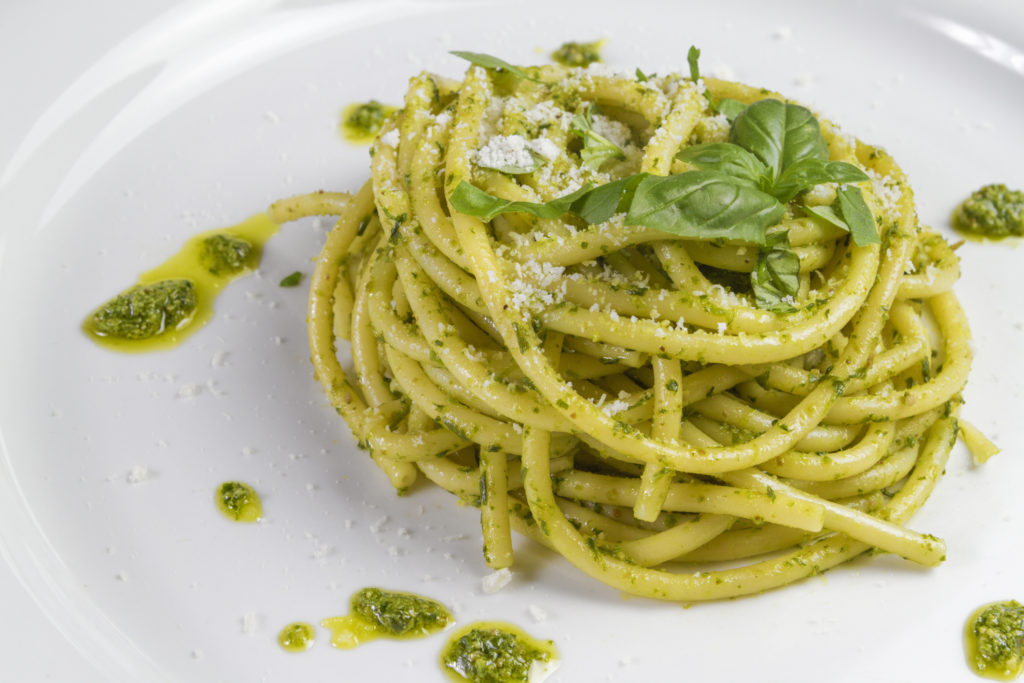There is a reason that pasta is often pegged as comfort food — the type of hearty, satisfying dish enjoyed amongst friends and family. For centuries, pasta has been a staple of the Mediterranean diet, helping stretch garden-fresh vegetables and other toppings into balanced, nourishing meals that multigenerational families shared together. According to lifestyle medicine expert Dr. David Katz, who joined Oldways on a culinary tour of Sicily in 2018, “Pasta figures famously in some variants of the traditional Mediterranean diet, which in turn figure among the diets practiced by the longest-lived, most vital populations known.”
The Little-Known Health Benefits of Pasta
When pasta dough is extruded through dies (pressed through molds) to make the shapes, it compacts the starch structure. This is why pasta digests more slowly and has a gentler blood sugar response. In the Scientific Consensus Statement on Healthy Pasta Meals, nutrition researchers from around the world affirmed: “There is a beneficial effect in the way pasta is made. The process of manufacturing reduces its glycemic response.” Based on the evidence, they conclude that “pasta meals and other low-Glycemic Index foods may help control blood sugar and weight especially in overweight people.”
People who eat more pasta tend to have more well-balanced diets in general, probably because pasta is such a wonderful vessel for vegetables, fresh herbs, olive oil, seafood, and other nutritious ingredients. A study of 10,697 adults found that those who ate pasta and noodles had slightly higher Healthy Eating Index scores, a measure of diet quality. Specifically, pasta eaters got about 2 grams more fiber per day than those who don’t eat pasta, as well as slightly higher levels of potassium.
The traditional Mediterranean diet is filled with countless examples of balanced pasta meals that incorporate vegetables, legumes, fish, olive oil, and other nutritious ingredients. Below are four key tips for enjoying healthy pasta meals the Mediterranean way.
Tried-and-true Mediterranean Diet Tips for Building Healthy Pasta Meals

Use pasta as a canvas for healthy ingredients like vegetables. The healthfulness of a pasta dish depends on the company it keeps. “Instead of thinking of pasta as the main component of that pasta dish, think about the vegetables as the main component of the pasta dish,” recommends registered dietitian Sheela Prakash, the author of Mediterranean Every Day. By flipping the script, you can use pasta as a vessel to help you meet your other nutrition goals. Rather than a fettucine alfredo or macaroni and cheese, try a dish like pesto pasta (pasta with a sauce made from leafy green herbs like basil and heart healthy nuts), pasta con le sarde (pasta with sardines), or orecchiette con cime di rape (pasta with broccoli rabe).
Cook pasta al dente. Al dente is Italian for “to the tooth.” Traditionally, Italian families cook their dried pasta to a firmer texture, with a slight bite to it (a texture they call al dente), rather than cooking it soft and mushy. Today, we understand the inherent wisdom in this practice, as pasta boiled for shorter periods of time has a gentler impact on your blood sugar than overcooked pasta. To achieve your own al dente pasta, simply take 1-2 minutes off the suggested cook time on the pasta package.

Try a whole grain pasta. Just as certain wines pair better with certain dishes, there are certain pasta toppings and sauces that best complement the rich, nutty flavor of whole grain pasta. Try pairing whole grain pasta with mushrooms, strong cheeses, and bold, rich sauces. Best of all, swapping in whole grain pasta will add a boost of fiber to your meal, as well as higher levels of many essential nutrients. Research also indicates that whole grain pasta can help reduce appetite compared with refined pasta, meaning that it is easier not to overeat.
Opt for smaller portions. At traditional Italian trattorias, pasta is often listed on the primi section of the menu to serve as a first course or as a lighter meal. Pasta portions in a traditional Mediterranean diet are much smaller than we might find on many American tables. At home, aim to get 6-8 servings from a one-pound package of pasta. By tossing your pasta with a generous amount of healthy ingredients (like roasted vegetables, beans, sauteed greens, or fresh tomatoes), a smaller amount of pasta can stretch into a hearty, satisfying meal.


 Oldways
Oldways